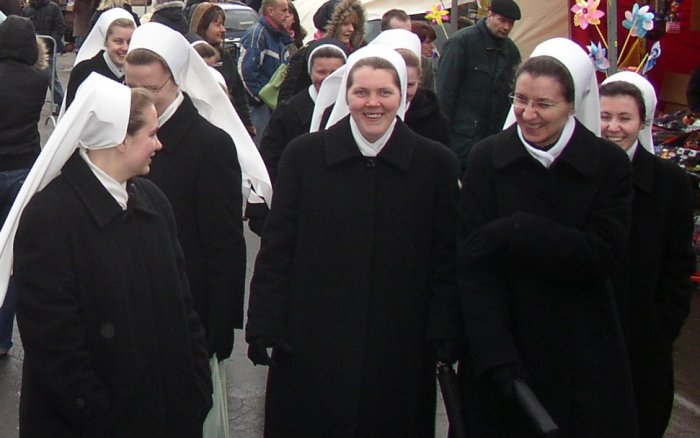By EDDIE MIKUS
STAFF WRITER

Courtesy of Wikimedia As shown by A Question of Habit, the realities of nuns’ lives are quite different from idealized American perceptions.
A panel discussion held by the Francis and Ann Curran Center for American Catholic Studies explored some of the differences between perception and reality of the life of religious women.
The panel featured Bren Ortega Murphy, a professor at Loyola of Chicago who produced a film called A Question of Habit, which was shown in its entirety at the discussion.
Other panelists were Sister Judith Kubicki, CSSF, from the theology department, Professor Robin Andersen from the communication department and Brenna Moore from the theology department.
Murphy explained that part of her rationale in making the film was to promote the actual lives of nuns instead of how they have been idealized in modern American society.
“The answer isn’t to try to get rid of [objects on which nuns have been commercialized], it’s to get more stories out there,” Murphy said.
In an interview with The Fordham Ram, Christine Firer Hinze, director of the Curran Center, explained the significance of women religious to American life.
“They have played a big role in American Catholic life,” Hinze said. “What we’ve had in this country are many communities of sisters who lived in community but also were dedicated to ministries outside the convent walls. For example, teaching, hospitals, orphanages.”
Hinze also said that there was a difference between nuns and sisters because nuns spend their entire lives inside of cloisters.
According to the film, however, the contributions of American nuns have been overshadowed by media-driven misperceptions. For example, the film explored how the portrayal of nuns shifted from the happiness of the 1960’s sitcom “The Flying Nun” to a more recently stern stereotype.
In remarks delivered after the film, Andersen spoke about how the impact of the media has shaped how the American public views religious women.
“When you take a myth and an icon and something that is so terrifically stereotyped, as we saw, and understanding that you can write any narration into that icon which essentially has no meaning, the question becomes ‘How can you tell the story of these people’s lives,’” Andersen said. “These are all narratives of exclusion, because these people are outside the lens of our society.”
A misconception about nuns that the film particularly attacked was the idea that all nuns wear black habits, an idea which was portrayed as out-of-date and used to objectify nuns.
“What amazes me is that people still feel, even on television and film, that they still have to put the nun in the habit,” Murphy said.
Kubicki commented on how habits are perceived in American culture.
“In our culture, now so many years after sisters have stopped wearing the habit, there are whole generations of people who have never experienced sisters in a habit,” Kubicki said. Referencing various trinkets on which women religious are portrayed, she added, “And so for them, these kinds of kitsch items and so on are kinds of cute suggestions about a past that they don’t know anything about.”
Additionally, Kubicki also spoke about her personal use of the habit.
“For most of my religious life, I was wearing a habit because my old community, it was pretty late in the development of changes that we finally had the option of wearing the veil or not wearing the veil,” Kubicki said. “My own experience was, there was a sense of who you were, you didn’t have to explain it, and people assumed certain things about you when you were wearing it.”
Kubicki also explained, however, the circumstances under which she decided to stop wearing the habit.
“In my own life and ministry, it soon became clear to me that I was experiencing the wearing of the habit as something that increasingly separated from the people I was working with,” Kubicki said. “That was one of the reasons why I decided it was not working in my ministry to continue wearing the habit.”
Moore compared the perception of nuns in America to the perception of nuns in other locales at other points in history.
“In the context of 19th-and 20th-century France too, the image of the nun was prominently present in political cartoons, for example,” Moore stated. “But it was a more, I’d say, monochromatic image, and it was the image of the nun as absolutely intellectually and sexually repressed, and that the nun needed liberation. Who was going to provide liberation? The secular political sphere. This image of the veiled nun, this image of the veil as the tomb, the veil as the prison, really was central to anti-clerical discourse of French secularism. And today, that’s kind of died down somewhat, except that the veiled woman has reappeared in French political discourse, because of the Islamic woman.”
Moore made reference to controversial French laws which ban religious symbols in schools and face covering in public. Both laws are perceived to target Muslim women who wear veils.
•
Disclaimer: Eddie Mikus is also a part of the American Catholic Studies Program.
Categories: News
Tags: eddie mikus
 Students, Unafraid to Celebrate Spring, Flock to an Alcohol-Stained Eddie’s
Students, Unafraid to Celebrate Spring, Flock to an Alcohol-Stained Eddie’s  Months After Captivity, Richard Engel of NBC News to Deliver Fordham’s 168th Commencement Address
Months After Captivity, Richard Engel of NBC News to Deliver Fordham’s 168th Commencement Address  USG ELECTION GUIDE
USG ELECTION GUIDE  First NYC Autism Speaks U Branch Honored at NASDAQ Bell
First NYC Autism Speaks U Branch Honored at NASDAQ Bell  New Networking Organization Unites New York City Colleges
New Networking Organization Unites New York City Colleges